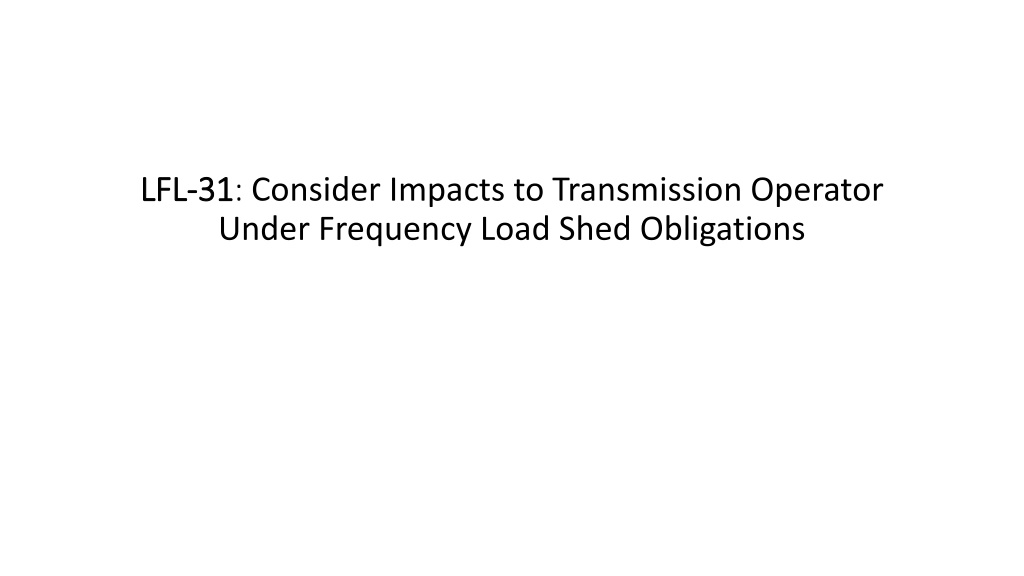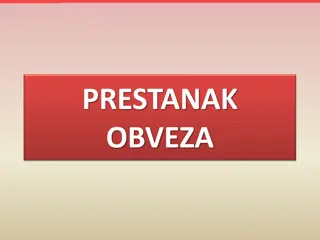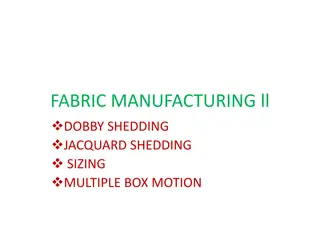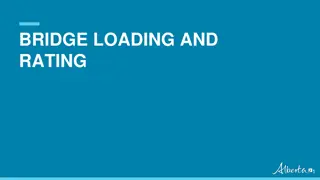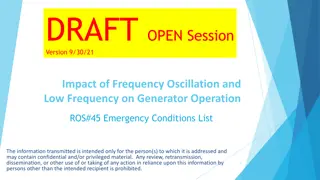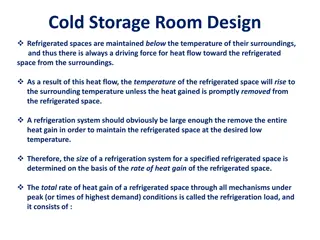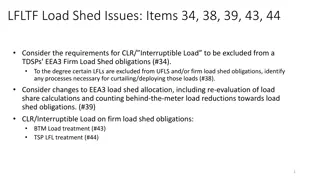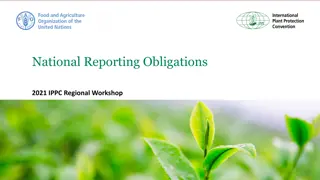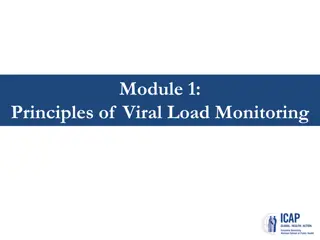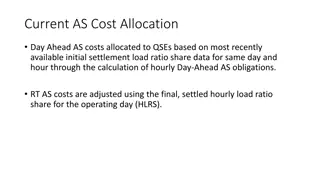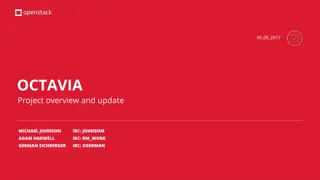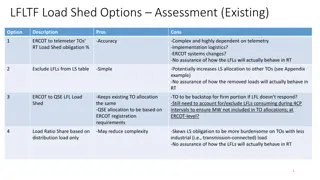Understanding Transmission Operator Obligations in Under-Frequency Load Shedding
ERCOT Compliance ensures that Transmission System Operators (TSOs) and Distribution System Operators (DSOs) have automatic under-frequency load shedding circuits in place to provide load relief during under-frequency events. The TSOs are required to shed a specific percentage of their connected loads based on frequency thresholds. Adding significant generation resources can pose challenges, but potential solutions include sharing load shedding responsibility with flexible load reduction steps and implementing voluntary load shed programs. Existing rules guide how load drops are counted against obligations. Awareness and coordination among parties are critical in effectively managing under-frequency load shedding.
- Transmission operators
- Under-frequency load shedding
- ERCOT Compliance
- Load shedding circuits
- Grid conditions
Download Presentation

Please find below an Image/Link to download the presentation.
The content on the website is provided AS IS for your information and personal use only. It may not be sold, licensed, or shared on other websites without obtaining consent from the author. Download presentation by click this link. If you encounter any issues during the download, it is possible that the publisher has removed the file from their server.
E N D
Presentation Transcript
LFL LFL- -31 31: Consider Impacts to Transmission Operator Under Frequency Load Shed Obligations
ERCOT Compliance coordinates and conducts an annual survey with the TSPs and DSPs to ensure that the required automatic under-frequency load shed circuits are configured to provide the appropriate load relief in an under- frequency event as required by table below from Operating Guides 2.6.1(1) Requirements for Under-Frequency Load Shedding: 2.6.1 (1) At least 25% of the ERCOT System Load shall be equipped at all times with provisions for automatic Under- Frequency Load Shedding (UFLS) as described in this paragraph. In the event of an under-frequency event, each Transmission Operator (TO) shall provide Load relief by shedding the required percentage of its Distribution Service Provider (DSP)-connected Load and transmission-level Customer Load using automatic under-frequency relays, as specified in the table below. For the purposes of this paragraph, the TO Load will be the amount of Load being served by the DSPs that the TO represents, as well as the TO s transmission-level Customer Load, when the ERCOT frequency drops to the 59.3 Hz threshold. As such, the amount of the TO Load relief will not include any Load that has already been shed prior to the 59.3 Hz frequency threshold. The under-frequency relays shall be set to provide Load relief as follows: Automatic Firm Load Shedding Frequency Threshold TO Load Relief 59.3 Hz At least 5% of the TO Load 58.9 Hz A total of at least 15% of the TO Load 58.5 Hz A total of at least 25% of the TO Load
Transmission Operator UFLS Obligations: Potential Issues With Adding 17 GWs of LFL s High concentration of LFL s can result in system overload in an area that is exacerbated by load dropping in other areas. Flexibility to be in market one day and out the next day Flexibility to dodge 4CP and not give ERCOT true picture of Load Load is on during 4CP but has no commitment to shed load during system emergencies Will we put a Transmission Voltage customer on Load Shed? Some Loads are in the market. Some are not. Nothing requires load to participate.
Transmission Operator UFLS Obligations: Potential Solutions for Adding 17 GWs of LFLs LFL shares responsibility to shed load when grid conditions warrant: Design so that the load is not shed at the transmission level breaker Small Load Reduction steps on customer side (i.e., 5-10-10) Note: Not helpful to shed the 25% in one step Register as a Controllable Load Resource Follows ERCOT load reduction instruction Implementation of a Voluntary Load Shed program where loads agree to be curtailed during (or before? ) Emergency conditions for no compensation. Voluntary and confidential? Does the affected utility have awareness? Loads would be removed from Load Shed Table although still responsible for 4CP charges
Transmission Operator UFLS Obligations: Potential Solutions (cont.) Protocols, Guides, Rule Existing rules for Load Resources that trip, the load drop can be counted by the TDSP against 5-10-10 obligation Problem is that the TO doesn t know that in Real-Time ERS participation that TO has awareness of. Multiple types of LFL Agreements: One for Transmission Interconnection May involve more than one Electric Utility (utility to utility) One for Retail load? Some TSPs (ETT, LCRA, WETT, CTT, etc.) do not serve Load. Load could be served by GSEC or AEP Texas, for examples.
Transmission Operator UFLS Obligations Related Issues Are LFLs Critical Load ? And, therefore not subject to load shed. Consider the requirements for CLR/ Interruptible Load to be excluded from a TDSPs' EEA3 Firm Load Shed obligations. (Oncor: LFL-34) To the degree certain LFLs are excluded from UFLS and/or firm load shed obligations, identify any processes necessary for curtailing/deploying those loads. (AEP/Oncor LFL-38) Consider changes to EEA3 load shed allocation, including re-evaluation of load share calculations and counting behind-the-meter load reductions towards load shed obligations. (Oncor: LFL-39) LFL Shed prior to/during EEA: (Billo/Solis; LFL-40) CLR/Interruptible Load on firm load shed obligations: BTM Load treatment (Oncor: LFL-43) CLR/Interruptible Load on firm load shed obligations: TSP LFL treatment (Oncor; LFL-44) ERS participation NPRR1094 / NOGRR233: Allow Under Frequency Relay Load to be Manually Shed During EEA3 o removes the prohibition from manually shedding any UFLS feeder-connected Load during an EEA Level 3. TOs and TDSPs would be allowed to shed UFLS feeder-connected Load as long as they continue to maintain the required percentage levels of UFLS. o Reduces the risk of significant overshoot in frequency in the event of a UFLS operation while UFLS levels substantially exceed the required levels. o PUC Project No. 51888: REVIEW OF CRITICAL LOAD STANDARDS AND PROCESSES
